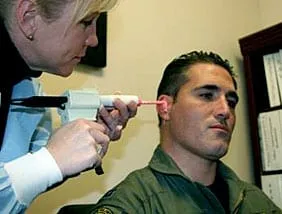Do you work a noisy job? Or do you hate the feeling of water in your ears when you shower or swim? Are you a musician who plays instruments in loud settings? If you answered yes to any of these questions, then a custom earplug might be right for you.
So how do you get custom earplugs made? To get custom earplugs made, see your audiologist or hearing care professional. These professionals are trained to take proper earmold impressions in a safe manner. The impressions are sent to a lab to create a custom earplug just for you.
So what are custom earplugs? Are they any better than disposable earplugs? How exactly does the process work for obtaining the custom earplugs? Continue reading to find out more!
What Are Custom Earplugs?
A custom earplug (sometimes called personalized hearing protection) is a special earplug made specifically for an individual’s ear. Custom earplugs may be made to help in the prevention of noise-induced hearing loss from a noisy job or could be used as a plug for preventing water from getting in the ear when swimming or bathing. Custom earplugs can also be made for musicians, which allow for the reduction of certain sounds while enhancing the musical experience.
For those individuals who work in a noisy factory setting with loud machinery, custom earplugs are often required in an attempt to preserve the workers’ hearing. In these situations, workers are also often required to have their hearing tested at least annually. Hearing levels may be tested both with and without the earplugs to see if the earplugs are actually working to reduce noise.
Earplugs can be used to prevent water from getting into the ear canal when swimming or bathing. This may be useful for people (especially children) who have had pressure equalization tubes placed in their ears due to recurrent ear infections.
These individuals are often encouraged to not get their ears wet since the pressure could cause discomfort and the moist environment could lead to infection. An earplug with a good seal can allow those individuals to swim and bathe like normal without worrying about water leaking into the ear.
Musicians practice and perform in a variety of settings. They are often exposed to high levels of sound for extended periods of time. Some musicians utilize the musician’s earplugs, which reduce sound levels evenly so that music and speech are clear and comfortable. This helps the musician to hear his or her own instrument and how it blends with other instruments.
Custom earplugs are made by taking a mold (or impression) of an individual’s ear. That mold is then sent to a lab to make a custom earplug that fits the individual’s ear more accurately and snuggly than a disposable earplug. Molds are usually made of acrylic or silicone and fit in the ear and ear canal tightly, yet comfortably.
Custom earplugs are usually delivered in a protective storage pouch and come with lubricant. The lubricant can be applied to the earplugs during their initial use. This helps with easier insertion and improves comfort when just getting used to the new custom earplugs.
Why Choose Custom Earplugs Over Disposable Earplugs?
Disposable earplugs are often made from foam and are designed for limited use (one to a few times before disposing of). To use disposable earplugs, the wearer rolls the foam down into a small cylinder and then inserts it deeply into the ear canal, allowing it to expand and fill the ear canal.
Disposable earplugs are useful in some situations, however, they do not provide the perfect fit that a custom earplug offers. Disposable earplugs are generally made and therefore are not designed to reduce a lot of noise. Slit leaks between the earplug and the ear canal allow sound waves to travel past, therefore not working to reduce dangerous noise levels. If the generally shaped foam cylinder is too big or too small, or if it does not fit well in the ear due to curvy canals, you are not getting the most benefit.
Custom earplugs, when fitted properly, should provide a tight seal in the ear. This means that there would be no leaks where sound waves can enter. Since custom earplugs are designed for a better fit, more noise reduction, and better comfort, they are often considered the better option over disposable earplugs.
What Are the Advantages and Disadvantages of Custom Earplugs?
Like almost every product on the market, there are both positives and negatives to custom earplugs. Listed below are the advantages, as well as some of the disadvantages of investing in custom earplugs.
The Advantages of Custom Earplugs:

- Quality Earmold Impressions for Best Fit: It all starts with the earmold. A trained professional knows just how to make an earmold impression that can be used by the lab to create your custom earplug. The impression must be complete so that your earplug fits well into your ear without pain. Your earplug should be comfortable to wear, be easy to insert and remove and work to reduce noise.
- Quality Materials Used: Custom molded earplugs are commonly made with quality acrylic or silicone materials. These materials are made to last several years with proper care. The earplug can be easily cleaned with warm water and mild soap. Other materials may also be available for people who have allergies to silicone or acrylic.
- Appropriate Fit and Comfort: Some ear canals are too large or too small for disposable, non-custom earplugs. Some ear canals are too curvy or narrow to keep the disposable earplug in place. For this reason, custom earplugs may be a better option. Since custom earplugs should fit perfectly into a person’s ear, the noise will be reduced more and comfort should be improved. No sensation of pain or pressure should be present when the earplug is in place.
- Noise Reduction: Custom earplugs that fit properly will reduce noise more than disposable earplugs that are not the perfect fit. Custom earplugs can also be made with filters so that the amount and type of noise reduction delivered is no more or less than needed, depending on the environment. A solid custom-molded earplug can provide about 25-30 dB of noise reduction. Filters can be inserted into the earplug that will allow that noise reduction to be lowered to a specific level. This may be useful for people who only need a small amount of noise reduction but still need to be able to communicate with others. Musician earplugs also commonly have filters so that specific pitches can be heard while still protecting from harmful noise levels.
- Cost: Properly fit custom earplugs are a more expensive purchase than disposable earplugs. However, if the custom earplugs are properly used and maintained, they can last for several years and are therefore a more cost-efficient investment than using pair after pair after pair of disposable earplugs.
The Disadvantages of Custom Earplugs:
- Requires Proper Insertion for Adequate Protection: If custom earplugs are not properly inserted, they are not sealing off the ear from dangerous noise levels. Therefore, they must be easy for the user to insert and remove. If the earplug is only inserted partially, leaks are present between the earplug and the ear canal. This not only does not help to reduce noise, but it also may cause discomfort.
- Takes Some Time to Break-In: Custom earplugs may have a break-in period of several days. Since the earplugs are brand new, they are often very dry and smooth, making it difficult to slide and move over the skin. During this time, the user may want to use a lubricant for proper insertion into the ear canal.
- Does Not Last Forever: Though custom-molded earplugs should last longer than disposable earplugs. They are not designed to last forever. Over time, the ear canals can change shape. Even a small difference in the shape of the ear canal can make the earplugs fit differently from when they were initially fit. For children, this is inevitable as they grow. Additionally, the earplugs may form cracks and break apart after years and years of use. Therefore, it is likely that the earplugs will need to be replaced after several years.
How Can I Get Custom Earplugs Made?

To get custom earplugs made, see your audiologist or hearing care professional. These professionals are trained to take proper earmold impressions of your ear in a safe manner. They will often begin by looking at your ear and ear canal and removing any excess wax that may get in the way. If your ear canal is plugged with wax, you will want to get it completely removed prior to having an impression made of your ear.
The next step is to insert a small sponge into the ear canal. This prevents the earmold material from going too far into the ear canal. Next, the professional will fill the ear canal with the earmold material. This is usually a mixture of putty that hardens or cures after several minutes. When the putty has cured, the professional will pull your ear to break the seal between the putty and your ear. He or she will then remove the earmold impression from the ear. This impression is sent to a lab to be used for a mold of your earplugs. You will often be given a choice of colors, materials, and designs to choose from.
When the earplug arrives from the lab, the hearing care professional can schedule an appointment with you for an earplug fit. At this appointment, he or she will make sure that the earplugs fit properly, teach you how to insert and remove them, and answer any additional questions you may have.
Related Questions
How much do custom earplugs usually cost? Cost is generally between $100-150 per pair. The cost is usually very similar no matter what style you get such as for noise protection, swimming, or sleeping earmold. The cost will vary on the location in which you buy. Call a local audiologist’s office to find out exact prices.
How long do custom earplugs last? If the earmold is made out of a soft silicone material it will usually last at least 3 years or 700 uses. If it is made out of hard material called acrylic it should last for 5 years.

